"Antique Two Handled Footed Jar By Watano, Kutani, Meiji Period (1868 -1912)."
This late 19th-century signed jar illustrate the intricate artistry for which Kutani ware is renowned. The jar, elevated on three legs, features two elegantly painted handles and vibrant overglaze painting, a hallmark of Kutani porcelain. Most Kutani porcelain has painted surfaces (landscapes, flowers, and/or people) surrounded by scrolled red diapers (a red framing called Akae). On bottom marked Watano-sei, made by Watano, Kutani ware. The family Watano produced and exported Kutani ware for generations through the 19th and early 20th centuries. Watano was very famous during Meiji period (1868-1912) with export offices in the port towns of Kobe and Yokohama to be close to export trading hubs. The jar's surface is adorned with traditional Japanese motifs, including scenes of nature, cherry blossoms, chrysanthemums, and human figures, rendered in the bold, sharp lines characteristic of Kutani ware. Raised enamel dots and textured elements on the figures, flowers, and trees give a three-dimensional effect, adding depth to the already detailed pictorial design. The jar displays Kutani’s signature colors—earthy red, deep green, and yellow—often applied against a grayish base, reflecting traditional Meiji-era Kutani aesthetics. The jar’s decorations are heavily influenced by classic Japanese symbols of nature and culture, capturing both floral and figurative elements with precision and elegance. Kutani ware was first made in Kaga, Ishikawa in 1655, but then there was a pause in production until it was revived in the Meiji period (late 19th century) when Japan began exporting goods to the West. Kutani ware became a favored export item, with its vibrant designs catering to Western tastes while preserving traditional Japanese artistry. A three-character mark is inscribed at the base, characteristic of antique Kutani items. These markings can be challenging to interpret, even for native Japanese speakers, but add to the piece's authenticity and value. Kutani ware, especially pieces from the late 19th century, is highly sought after in the antique market. The jar’s combination of historical significance, intricate design, and unique craftsmanship places it among the valued collectibles of Japanese porcelain. This jar stands as a testament to the enduring legacy of Kutani ware, reflecting the cultural and artistic revival of Japan in the Meiji period while also catering to the growing demand for Japanese decorative arts in the Western world.
Dimensions: height 22.5 cm, width 17.5 cm, depth 16 cm, weight 1261 grams.
Condition: the paint on the legs is worn off - otherwise excellent condition.
Please, study the accompanying photographs carefully as they form an integral part of this description. The item will be shipped with full tracking and insurance. It is important to note that shipping costs include labour, packaging and postage.


















































 Le Magazine de PROANTIC
Le Magazine de PROANTIC TRÉSORS Magazine
TRÉSORS Magazine Rivista Artiquariato
Rivista Artiquariato